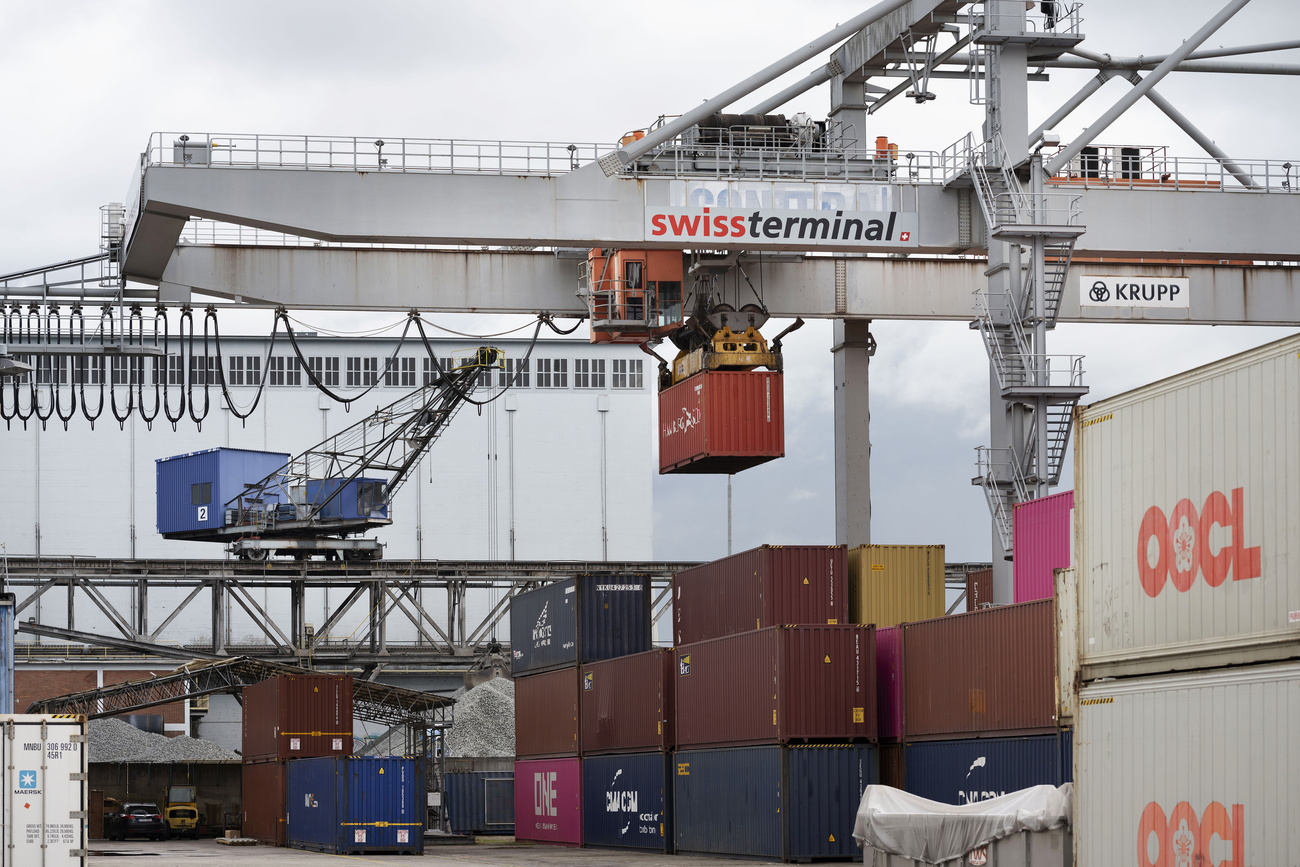
Switzerland’s economic outlook for 2022: what lies ahead

Supply chain headaches, inflationary pressures, the new Omicron variant, the strong franc and stiff competition facing the pharma and banking industries – SWI swissinfo.ch journalists outline the major issues likely to have an impact on the Swiss economy in 2022.
1. Strong economic growth vs. Omicron uncertainties
After a solid +3.5% rebound in growth this year, Switzerland’s economy should again experience higher than average growth in 2022. The State Secretariat for Economic Affairs (SECO) forecasts 3% GDP (gross domestic product) growth, with supply chain problems and new health measures in response to the new Covid-19 Omicron variant contributing to the slight slowdown.
The labour market has fully recovered from the pandemic. Businesses are finding it difficult to find skilled workers in areas such as IT, architecture, the chemical and pharmaceutical industries, and mechanical engineering.

More
2022: Switzerland in search of itself
The lack of skilled workers is also higher than average in the health and social services sectors, according to a recent study by Credit Suisse. SECO predicts that Switzerland’s unemployment rate should decline over the next two years from 3% in 2021 to 2.4% in 2022, and 2.3% in 2023.
2. Inflationary risks
In addition to fears about the emergence of new Covid variants, the threat of inflation — currently higher than expected in both the United States and the eurozone — is also cause for concern.
“I assume that inflation will subside on its own, even if the interest rates do not change,” says Katrin Assenmacher, who is head of monetary policy strategy at the European Central Bank (ECB) and used to work at the Swiss National Bank (SNB).
In the US, the signs nonetheless indicate a rise in interest rates. Chair of the US Federal Reserve Jerome Powell is seen as a proponent of tight monetary policy, leading experts to question how long the US central bank will remain a spectator before tightening — if necessary — monetary policy.
Higher interest rates would also put pressure on the SNB to raise rates, a move that would lead to a further strengthening of the Swiss franc. In such a scenario, parity between the Swiss franc and the euro could become a reality.
3. Swiss pharma – competition from all sides
A key driver of Swiss exports, and responsible for more than a third of GDP growth since 2010, the pharmaceutical industry is expected to continue its upward trajectory next year. But foreign competition is tougher than ever. Ireland, Denmark, the San Francisco Bay area in the US, and Singapore are all actively wooing pharmaceutical companies.
The Swiss pharma giants Roche and Novartis face stiff competition from new biotech players such as BioNTech and Moderna [the companies behind successful mRNA Covid-19 vaccines], as well as from tech giants Google and Amazon, which are using artificial intelligence (AI) and Big Data to carve out shares in the lucrative health sector.

These major challenges come at a time when health systems the world over are under increasing pressure and governments are challenging the prices of new drugs coming to market. To compete, Swiss pharma will be forced to invest massively in both research and the acquisition of companies active in the development of personalised drugs and treatments, the latest Holy Grail of the pharmaceutical industry.
4. Industry picks up again
Having suffered its worst year in history in 2020, Swiss watchmaking, driven by strong demand from China and the US, has well and truly recovered in 2021. And while there are still uncertainties, the market is expected to continue to improve in 2022. But much depends on how and when international tourism — essential to luxury markets — recovers. The most optimistic experts predict exports will reach CHF21-22 billion ($23-24 billion), close to the record set in 2014.

More
The arts in Switzerland: what to watch for in 2022
Less visible than the watchmaking industry, but much more important in terms of exports and Swiss jobs (320,000 jobs), the machine, electrical engineering, and metals industry (MEM) is also optimistic about the future. In a sector that has suffered acutely from the effects of the pandemic, order books are again full, and turnover has seen a net increase.
However, the industrial sector is under severe pressure from the lack of supplies, and related price hikes of key raw materials. The strengthening of the Swiss franc against the euro appears to have been absorbed by industry. Many managers used the crisis to invest in innovation, thus improving their competitivity.
5. Banks, blockchain and a potential real estate bubble
Banks will keep a close eye on inflation and interest rates in 2022. If the rise in consumer prices become too steep or prolonged, it could move Swiss interest rates into positive territory for the first time in years. That would be good news for investment bankers but could also expose mortgage loans to repayment defaults from homeowners. Both the SNB and the Swiss Financial Market Supervisory Authority (FINMA) have warned banks on numerous occasions that their rapidly expanding portfolios of mortgage loans could come back to haunt them.

FINMA now obliges banks and other financial companies to report their exposure to climate change-related risks. This includes investments in fossil fuel companies and projects. The new trend towards sustainable investing promises fresh revenue streams, but only if it is done correctly. Non-governmental organisations (NGOs) will be vigilant to any attempts to fool investors into believing they are putting their money into green finance if the bonds and funds do nothing to help the environment and society.
Finally, banks must be alert to new technological advances in the world of finance. Several digital banks have already carved out a niche in the territory of traditional finance. The new kids on the block are cryptocurrencies and decentralised finance, which automates trades with the intention of cutting out intermediaries, like banks. Blockchain is unlikely to tear up traditional finance in 2022, but banks are on notice that their way of life is being challenged by the new technology.
More
6. Multinationals face a new playing field
Multinational companies will be under increasing pressure from regulators, investors and NGOs to clean up their supply chains. From 2022, large companies in Switzerland will be required to report on social and environmental issues. From 2023, companies in high-risk sectors such as mining will also be required to conduct due diligence for risks of child labour and minerals sourced from conflict areas.
Campaigners behind the “Responsible Business” initiative, which was narrowly defeated in a nationwide vote in 2020, say the new law doesn’t go far enough and will continue to push for stronger accountability of companies for their impacts abroad. The European Commission is expected to come to a long-awaited decision on responsible business in 2022 that could go further than the Swiss law.
Multinational companies will also be tested in other contexts such as China and Myanmar, where there have been reports of widespread human rights abuses. Human rights activists will continue to take to social media to name and shame companies and investors who are seen as complicit in abuses.
7. Solid public finances
Healthy public finances are also the sign of a robust economy. Having plunged into the red over the past two years, the federal budget should regain some semblance of normality in 2022. The extraordinary CHF40 billion in spending necessary to weather the pandemic should be amortized in ten years, without it having cost taxpayers a cent. The government plans to use the budget surplus and profits from the SNB to pay the debt.
The long-term outlook is also very positive. Despite an increase in spending on training and costs related to the ageing population, the governmentExternal link estimates that Swiss public debt (federal, cantonal and communal) will, in the worst case scenario, grow from 30% of GDP to 51% by 2050.
By comparison, the average rate of debt in the eurozone is already close to 100% of GDP. According to the government’s economic modelling, this swelling of the state should not pose a problem for Switzerland because the nation’s overall prosperity should also see a “net increase” over the same period.

In compliance with the JTI standards
More: SWI swissinfo.ch certified by the Journalism Trust Initiative






























Join the conversation!